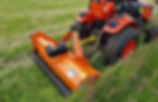Tips for using a flail mower
- Beckside Machinery
- Feb 8, 2022
- 3 min read
Using a Flail Mower is like re-thinking how you mow. In comparison to blades, flail mowers use banks of flails (or "knives"). A flail is a short portion of metal that breaks grass by beating it (flailing it). It does the job quite efficiently at high speeds. You may be familiar with Rotary mowers. Rotary mowers can go forward, backward, or even sideways. Due to the blades spinning parallel to the ground on a rotary mower, this occurs. This blade spins, cutting off the grass's base and causing the material to fall to the ground. It is possible to cut the grass again if the material or grass is tall as it falls. Usually, the material being cut is just below the cutting blade when it falls.
As the blades of the flail mower are spinning vertically to the ground, the grass or material to be cut is lifted and cut/chopped many times before it is ejected from the rear of the flail mower. Instead of falling out of the way, the material you are cutting is suspended under the mowing deck. The density and volume of the material that can be fed and cut is crucial to the performance of a flail mower. The speed is also crucial. Here are several tips on how to operate a flail mower.
Rule 1. Only cut forward when you use a flail mower. In the event you must back up, you will need to lift the mower deck as you do so. Whenever you are ready to continue mowing, lower your flail mower once more and continue to mow in a forward direction. Mowing in reverse will cause the shaft to wrap and the belts to burn up.
Rule 2. Flail mowers should be operated at a compact tractor's engine speed providing 540 RPM PTO speed. When it comes to maintaining the ability of the flail mower to lift the material it is cutting, blade tip speed is very important. Mowers will bog down at low PTO speed and power belts will slip and burn if they are operated at too low a speed. NOTE: This is not applicable to an ATV flail mower which will run from its own engine.
Rule 3. You should start your mowing project in the lowest gear possible. When the material exiting the back of the flail mower is not fully cut, increase the tractor's forward speed. Slow the tractor down gradually after increasing the forward speed. Using the tractor, material, and flail mower combination you have determined the maximum speed you can go in order to do this job properly. If you mow at a speed that is too fast for the mower to mow properly, the power belts will slip and burn causing the mower to fail. There is no bunching with a flail mower because it does not throw anything to either the left or the right.
Tips & Tricks
Even at minimum forward tractor speed, cutting height can be adjusted by adjusting Top center hitch link if material is too high or thick for one pass. Mowing normally requires adjusting the top link so that the mower sits with the front edge slightly raised. By extending the top hitch link, the mower's front edge can be lifted more if needed. With a larger area for the material to feed into the mower, the material will be cut at a higher level. The flail mower deck can then be lowered to its normal position and the project can be cut a second time at the desired height.
You must have Hammer type blades installed if you need to cut wood. While "Y" grass blades are capable of cutting small saplings and small limbs, they are unable to cut anything larger than these. In addition to cutting brush and grass, hammer blades can handle material up to 4" in diameter, depending on the size of the hammer available for your mower. Keeping the material under the mower deck for a longer period of time can cause a small delay in cutting dense materials.
